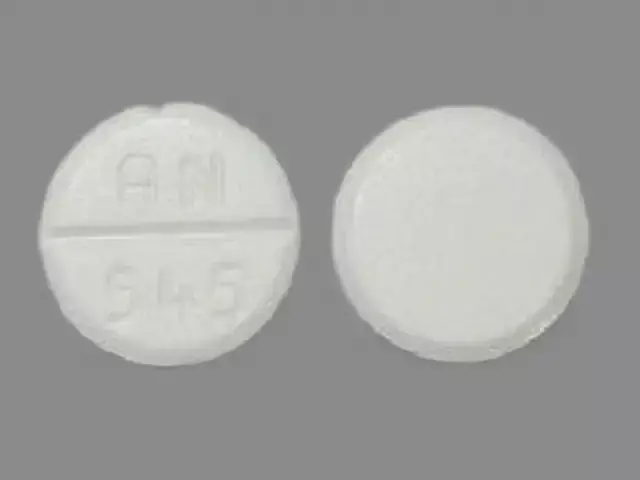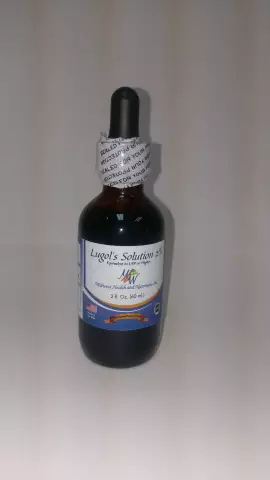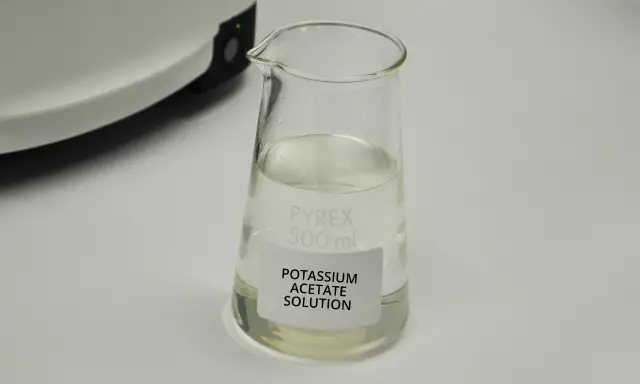- Author Rachel Wainwright [email protected].
- Public 2023-12-15 07:39.
- Last modified 2025-11-02 20:14.
Suprilamin
Suprilamin: instructions for use and reviews
- 1. Release form and composition
- 2. Pharmacological properties
- 3. Indications for use
- 4. Contraindications
- 5. Method of application and dosage
- 6. Side effects
- 7. Overdose
- 8. Special instructions
- 9. Application during pregnancy and lactation
- 10. Use in childhood
- 11. In case of impaired renal function
- 12. For violations of liver function
- 13. Use in the elderly
- 14. Drug interactions
- 15. Analogs
- 16. Terms and conditions of storage
- 17. Terms of dispensing from pharmacies
- 18. Reviews
- 19. Price in pharmacies
Latin name: Suprilamin
ATX code: R06AC03
Active ingredient: chloropyramine (Chloropyramine)
Manufacturer: VELFARM LLC (Russia)
Description and photo updated: 2020-18-01
Prices in pharmacies: from 108 rubles.
Buy

Suprilamin is an anti-allergic agent.
Release form and composition
Dosage forms:
- solution for intravenous (intravenous) and intramuscular (intramuscular) administration: slightly greenish, slightly yellowish or colorless transparent liquid with a characteristic odor amount from 1 to 3), 5 ampoules in blister contour packs, 1 or 2 packs in a cardboard box and instructions for use of Suprilamin; for hospitals - in corrugated cardboard containers of 200 blister contour packs with the same number of instructions];
- tablets: round, flat-cylindrical, almost white or white, practically odorless, with bevels on both sides and a cross-shaped line on one side (10 or 20 tablets in cell contour packs, in a cardboard box from 1 to 10 packs and instructions for drug; 10, 20, 30, 40, 50, 60, 70, 80, 90 or 100 tablets in a polymer can, in a cardboard box 1 can and instructions for Suprilamin).
Composition of 1 ml solution:
- active substance: chloropyramine hydrochloride - 20 mg;
- excipient: water for injection.
Composition of 1 tablet:
- active substance: chloropyramine hydrochloride - 25 mg;
- auxiliary components: sodium carboxymethyl starch (primogel and sodium starch glycolate), lactose monohydrate (milk sugar), povidone K25 (kollidon K25), microcrystalline cellulose, magnesium stearate.
Pharmacological properties
Pharmacodynamics
The active ingredient of Suprilamine, chloropyramine, is a chlorinated analogue of tripelenamine (pyribenzamine), a first generation antihistamine belonging to the group of ethylenediamine antihistamines.
Chloropyramine is a histamine H1 receptor blocker. In addition to the antihistamine, it has an m-anticholinergic effect. It also acts on the central nervous system (CNS), affects capillary permeability and smooth muscles.
After oral administration, the effect develops in 15-30 minutes, reaches a maximum within 1 hour and lasts up to 3-6 hours.
Pharmacokinetics
Regardless of the method of administration of Suprilamin, chloropyramine is rapidly absorbed and well distributed in the body, including the central nervous system.
It is metabolized in the liver.
It is excreted from the body mainly by the kidneys. In children, it is excreted faster than in adults.
In case of impaired renal and / or liver function, the metabolism and excretion of chloropyramine decreases, therefore the dose of Suprilamin is reduced.
Indications for use
Both dosage forms of Suprilamin are used in the treatment of the following conditions / diseases:
- allergic rhinitis (both seasonal and year-round);
- allergic reactions to insect bites;
- hives;
- food and drug allergies;
- itchy skin;
- atopic dermatitis;
- contact dermatitis;
- acute and chronic eczema;
- serum sickness.
In the form of an injection solution, Suprilamin is also used in angioedema as an adjuvant.
Contraindications
Absolute contraindications for both dosage forms of Suprilamin:
- acute attack of bronchial asthma;
- period of pregnancy and lactation;
- hypersensitivity to any component of the drug.
Additional absolute contraindications for certain dosage forms:
- solution: neonatal period (for both term-born and premature babies);
- tablets: children under 3 years of age, lactase deficiency, lactose intolerance, glucose-galactose malabsorption.
Relative contraindications for both dosage forms of Suprilamin (the drug should be used with caution):
- cardiovascular diseases;
- functional disorders of the liver and / or kidneys;
- hyperplasia of the prostate;
- retention of urine;
- angle-closure glaucoma;
- elderly age.
Suprilamin, instructions for use: method and dosage
Solution for intramuscular and intravenous administration
The predominant method of administration of the Suprilamin solution is intramuscular. Intravenous administration is allowed only in severe cases.
Adults are prescribed 1-2 ml (1-2 ampoules) per day.
For children, the recommended initial doses for i / m administration, depending on age, are:
- 1-12 months: 0.25 ml (¼ ampoules);
- 1-6 years: 0.5 ml (½ ampoule);
- 6-14 years old: 0.5-1 ml (½ - 1 ampoule).
Depending on the effectiveness, tolerability of the drug and the development of side reactions, if necessary, the dose is gradually increased, but not more than up to 2 mg / kg.
In the case of a severe course of an allergic reaction, treatment begins with a slow intravenous injection, then Suprilamin is administered intramuscularly or taken orally.
Patients with impaired liver / kidney function may need to reduce the dose of the drug.
Pills
Suprilamin tablets should be taken orally with food, swallowed whole and washed down with water.
For adults, the recommended dose is 1 tablet 3-4 times a day (daily dose - 75-100 mg).
Dosing regimen for children depending on age:
- 3-6 years: 12.5 mg (½ tablet) 2 times a day;
- 6-14 years: 12.5 mg (½ tablet) 2-3 times a day;
- 14-18 years: 25 mg (1 tablet) 3-4 times a day.
Depending on the effectiveness of therapy, the tolerability of the drug and the development of side effects, if necessary, the dose is gradually increased, but not more than 2 mg / kg.
The duration of treatment depends on the type of disease, the nature of its course, symptoms and their severity, as well as the duration of the disease.
Patients with impaired liver / kidney function may need to reduce the dose of Suprilamin.
Side effects
Suprilamin rarely causes side effects, therefore, clinical studies to determine the frequency of their development have not been conducted. The noted adverse reactions, as a rule, are temporary and go away on their own after the drug is discontinued.
The following negative effects may develop when using the drug:
- from the immune system: allergic reactions;
- on the part of the organ of vision: blurred vision, increased intraocular pressure, attacks of glaucoma;
- from the nervous system: dizziness, drowsiness, fatigue, headache, tremor, ataxia, nervous excitement, euphoria, encephalopathy, convulsions;
- from the gastrointestinal tract: dry mouth, increased or loss of appetite, constipation, diarrhea, abdominal discomfort, pain in the upper abdomen, nausea, vomiting;
- from the urinary tract: urinary retention, difficulty urinating;
- on the part of the cardiovascular system: lowering blood pressure, arrhythmia, tachycardia;
- from the musculoskeletal side: myopathy;
- on the part of the blood and lymphatic system: hemolytic anemia, agranulocytosis, leukopenia and other changes in the cellular composition of the blood (with prolonged treatment with the drug, for example, thrombocytopenia is possible);
- others: photosensitivity.
Overdose
Excessive excess of the dose of antihistamines, especially in children, is fatal.
Symptoms of chloropyramine overdose are similar to signs of atropine poisoning: impaired coordination of movements, anxiety, agitation, hallucinations, athetosis, ataxia, convulsions. Sometimes there is a fixed dilatation of the pupils, dry mouth, fever, hyperemia of the facial skin, urinary retention, sinus tachycardia. In young children, excitement usually predominates. In adults, facial flushing and fever may be absent, after a period of excitement, convulsions develop, then post-convulsive depression, coma, respiratory and cardiovascular failure are possible - these disorders within 2-18 hours can lead to the death of the patient.
The specific antidote to chloropyramine has not been established. Suprilamin has an anticholinergic effect, so gastric emptying is slowed down. If the drug was taken orally, it is recommended to induce vomiting, wash out the stomach and take activated charcoal during the first 12 hours.
Treatment of chloropyramine intoxication is symptomatic. The therapy is carried out under the control of the respiratory and cardiovascular systems.
special instructions
Chloropyramine enhances the effect of ethanol on the central nervous system, therefore patients are advised to stop alcohol during the period of treatment.
Taking Suprilamin late at night may worsen the symptoms of GERD (gastroesophageal reflux disease).
With prolonged use of antihistamines, disorders of the hematopoietic organs and the blood system may develop. Patients are warned about the need for a clinical blood test (including determining the number of formed elements) in case of an unexplained increase in body temperature, the appearance of laryngitis, pallor of the skin or jaundice, the formation of mouth ulcers, unusual and prolonged bleeding. If, according to the results of the analysis, a change in the blood formula is determined, Suprilamin should be canceled.
Suprilamin tablets contain lactose monohydrate (130 mg / pc.), Therefore they are contraindicated in case of glucose-galactose malabsorption, lactose intolerance, lactase deficiency.
Influence on the ability to drive vehicles and complex mechanisms
During treatment with Suprilamin, especially at the initial stage, drowsiness, dizziness and fatigue may develop. In this regard, at the beginning of therapy, patients are prohibited from driving vehicles and performing work with potentially dangerous consequences. The duration of the restriction is determined individually, depending on the tolerability of the drug.
Application during pregnancy and lactation
There have not been adequately controlled clinical studies on the effect of chloropyramine on pregnant women. There are known cases of retinopathy of prematurity (retrolental fibroplasia) in newborns whose mothers took antihistamines in the last months of pregnancy. Given these data, Suprilamin is prohibited from taking during pregnancy.
If treatment is required during lactation, women are advised to stop breastfeeding to avoid side effects in children.
Pediatric use
Suprilamin solution is contraindicated in newborns, tablets - for children under 3 years of age.
With impaired renal function
Chloropyramine and its metabolites are excreted mainly through the kidneys, therefore, patients with impaired function may need to reduce the dose and change the mode of taking Suprilamin.
For violations of liver function
With liver diseases, the metabolism of chloropyramine decreases, so a dose reduction may be required.
Use in the elderly
Elderly patients are more likely to experience side effects such as drowsiness, dizziness, low blood pressure, so Suprilamin should be used with caution.
Drug interactions
With the simultaneous use of ototoxic agents, chloropyramine can mask the early symptoms of ototoxicity of these drugs.
The anticholinergic effects of chloropyramine are enhanced and prolonged by monoamine oxidase (MAO) inhibitors.
With the simultaneous administration of Suprilamin and alcohol, a mutual inhibitory effect on the central nervous system is noted.
Special care should be taken if it is necessary to use simultaneously sedatives, hypnotics and anxiolytic drugs, barbiturates, atropine, tranquilizers, tricyclic antidepressants, muscarinic parasympatholytics, opioid analgesics. When combined, mutual amplification of the effects is possible.
Like all antihistamines, Suprilamin suppresses skin reactions in response to allergic skin tests. If necessary, they should be discontinued in a few days.
Analogs
Analogues of Suprilamin are Alerza, Acristil, Alerpriv, Allegra, Alerset-L, Allerfex, Allerway, Beksist-sanovel, Blogir-3, Glenset, Desal, Desloratadin, Delorsin, Diazolin, Diphenhydramine, Zodak, Zyrtectin, Klestinis, Levitra., Loratadin, Lordestin, Suprastin, Tavegil, Feksadin, Fenistil, Fenkarol, Chloropyramine, Cetirizine, Tsetrin, Ezlor, Erius, etc.
Terms and conditions of storage
Store in a dark place, out of the reach of children, at a temperature not exceeding 25 ° C.
The shelf life is 3 years.
Terms of dispensing from pharmacies
The solution is dispensed by prescription.
The tablets are available without a prescription.
Reviews of Suprilamine
Patients did not leave reviews about Suprilamine, however, there are many reports of other drugs that contain a similar active ingredient.
Chloropyramine belongs to the 1st generation antihistamines. It binds reversibly to H1 receptors, so high doses must be taken to achieve the effect. In addition, its effect is short-term, which entails the need for frequent administration of the drug throughout the day. And in high doses, chloropyramine causes drowsiness and sedation, and sometimes dizziness. This is what causes negative reviews of the drug from patients, and also limits its use in persons whose work is associated with the accuracy of coordination of movements and the speed of reactions.
As an antiallergic agent, patients respond positively to chloropyramine - it quickly and effectively eliminates allergy symptoms.
Price for Suprilamin in pharmacies
Approximate prices for Suprilamin:
- solution for i / v and i / m administration 20 mg / ml: 5 ampoules in a package - 99 rubles;
- tablets of 25 mg: 10 pcs in a package. - 43 rubles, 20 pcs. - 86 rubles, 30 pcs. - 130 rubles, 40 pcs. - 172 rubles., 50 pcs. - 216 rubles., 60 pcs. - 259 rubles, 70 pcs. - 302 rubles, 80 pcs. - 345 rubles., 90 pcs. - 389 rubles., 100 pcs. - 432 rubles.
Suprilamin: prices in online pharmacies
|
Drug name Price Pharmacy |
|
Suprilamin 25 mg tablets 20 pcs. 108 RUB Buy |
|
Suprilamin solution for intravenous and intramuscular administration 20 mg / ml 1 ml 5 pcs RUB 137 Buy |
|
Suprilamin 25 mg tablets 40 pcs. 196 r Buy |

Maria Kulkes Medical journalist About the author
Education: First Moscow State Medical University named after I. M. Sechenov, specialty "General Medicine".
Information about the drug is generalized, provided for informational purposes only and does not replace the official instructions. Self-medication is hazardous to health!






